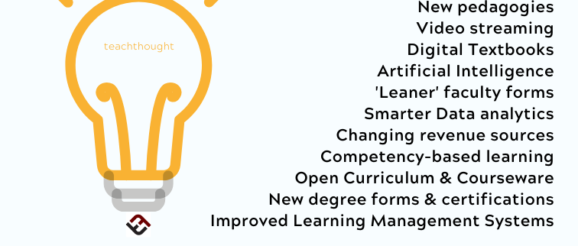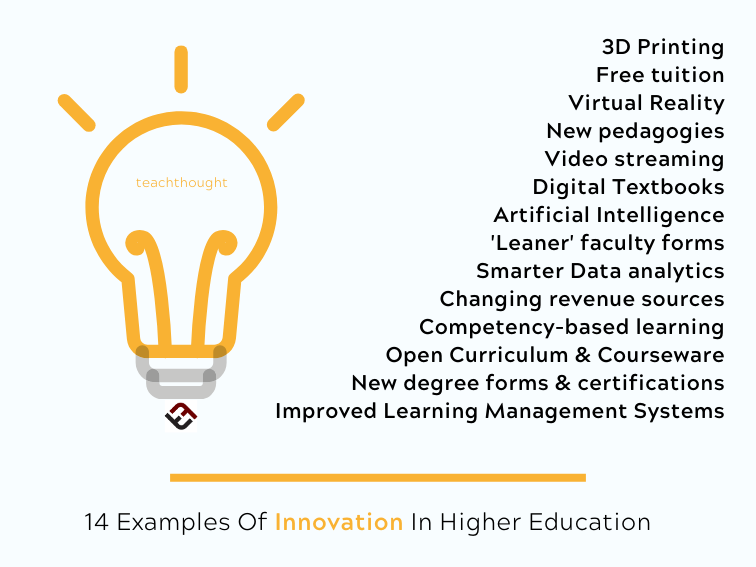14 Examples Of Innovation In Higher Education


14 Examples Of Innovation In Higher Education
by Terry Heick
In 2015, someone asked me what I thought about innovation in higher ed in an email, so I responded with a couple of hundred words, which I added to in creating this short blog post.
Today, I’m going back and updating the post with some new thinking, examples of innovation, a revised order, some links for context, and excerpts from longer papers on innovation at the university level.
I thought I’d share it because I haven’t talked much about higher ed, but for better or for worse, it is a big part of what we do in K12. I don’t follow higher education very closely, so this is all from 20 feet away. One of the big takeaways for me is how frustratingly little innovation there has been in higher ed. If this list seems underwhelming, that’s in part due to the underwhelming nature of the innovations.
Also note, the point of this post isn’t to showcase how innovative higher education is but rather to point out innovations that are out there as a kind of survey while also hopefully helping pollinate the possibility of innovation in the upper end of the field and ‘industry’ of education. With that in mind, I started out with the more common, perhaps less exciting examples.
Six Common Examples Of Innovation In Higher Education
1. Competency-Based Learning
Competency-Based Education is something I’m hearing more and more about, which is neither bad nor good, but worth understanding more carefully. In Preparing Students For A Modern Economy, I wrote:
“Schools don’t graduate employees, they graduate human beings. And just as universities haven’t been ‘job training facilities,’ more immediately, neither has K-12. The rub comes when universities seek to revise themselves. The more connected K-12 is to university goals and aspirations, the more K-12 is on the hook here as well to ‘tighten the curriculum’ to make it ‘more efficient.’ To straighten and shorten the path from student to ‘job.’ In thinking like this, we’re lowering our sights from person and place to job and market. When we seek to train students, we have to ask ourselves what we’re training them for, and make sure we can live with the consequences.”
Competency-Based Education isn’t necessarily an innovation, but a move to Competency-Based Education can lead to other innovations–using technology to personalize a student’s navigation of to-be-mastered content, for example. helps us understand the need for asynchronous access to this content, especially when this access is not through a dated university learning management system, but something more authentic to the student, maybe even accessed on their own mobile devices.
Competency-Based Education, at least in terms of the learning process (as opposed to content), should be more student-centered and efficient. That’s good. Not sure how that will translate to increased knowledge when that knowledge (and subsequent certification) is what the university has historically commodified (and thus has restricted). Also not sure how this will help one of the higher ed’s most urgent matters–out of control cost. Something that makes something else more efficient should have a slew of other positive effects elsewhere.
We shall see.
2. Video Streaming/Flipped Classroom/eLearning Trends
From Zoom to Skype to Webinars and even live streaming on social media itself, video is perhaps the most visible and common form of technological innovation in K-12 and higher ed.
Video, of course, enables other innovations. An example? The movement seems to, in pockets, be threatening the college lecture. As does–or should–YouTube. There is so much great content already published and accessible, that curation matters as much as creation.
None of this is particularly exciting, really. As in K-12, there is a lack of leadership in higher-ed, with every university or league for itself. This is further exacerbated by equity issues, where, in spite of programs claiming otherwise, the quality of one’s education is almost entirely dependent on how much money their parents make.
3. Open Curriculum
Open curriculum, like MIT’s OpenCourseWare, has been out for years but hasn’t disrupted much.
MOOCs are great ideas, but assessment and feedback loops and certification are among the many issues holding them back. And anymore, they end being the punchline of edtech jokes, somehow. I don’t agree with many of the grievances people seem to have with them. It may be a matter of what kind of expectations you’re bringing to your evaluation. Comparing an unsupported MOOC from 2008 to an in-person college experience isn’t apples to apples.
Compare that same MOOC to a self-determined learner Googling topics or searching reddit for information, and suddenly it’s not so bad. eLearning will eventually be at the core of the university experience rather than the fringe, I’d guess, but that’s vague: eLearning how? What content? What kind of delivery models? There’s a lot to consider.
4. Changing nature of faculty
Whether this is ‘innovation’ that results in a ‘leaner’ business model that offers an improved ability to pivot or simply an unfortunate effect of a lack of funding is up to you. However, there is a clear trend towards adjunct faculty and a mobile, ‘global’ faculty with new contractual relationships with higher education institutes.
In a 2016 article, ‘Innovation in Higher Education: Can Colleges Really Change?’, Dustin Swanger, Ed.D explained how faculty is changing.
Today, digital networks of information make access to data and areas of specialty ubiquitous, particularly in the scientific fields. Therefore, researchers no longer need to be in the same physical location to collaborate. This change will reduce the attractiveness of many universities for expert faculty. For example, a faculty member may choose to teach at a small institution in a rural setting, yet collaborate on research with faculty in a large urban environment.
5. Changing revenue sources for institution funding
With the Coronavirus already having a massive impact on the global economy, existing attempts at funding higher education institutions through state funding, federal subsidies, and other methods are going to have to be scaled up fast–along with significant cost-cutting. This makes ‘finding new business models for college’ among the most important innovations in decades.
And eLearning absolutely must be a part of that. Swanger’s article continues:
The 2008 recession had a devastating impact on the US economy; and, higher education was not insulated from that impact. In 2008 nearly every state in the nation significantly reduced state support for higher education institutions. In 2015, the fiscal support for higher education by state governments had not rebounded since the 2008 collapse. In their 2015 report, Michael Mitchell and Michael Leachman cite significant fiscal realities faced by higher education. For example, “Forty-seven states – all except Alaska, North Dakota, and Wyoming – are spending less per student in 2014-15 school year than they did at the start of the [2008] recession.” So how bad is public funding for higher education? In 2015, the average state spending per student was $1,805 which was 20% lower than the average state spending per student in 2007-08. While most states had moved toward restoring funding for higher education, almost none had reached pre-recession levels. In fact, 13 states had reduced their funding per student in 2014-15 school year. These reductions in state support forced colleges and universities, particularly those in the public sector, to increase tuition at a greater rate than inflation. In fact, after adjusting for inflation, on average, public universities have increased tuition by 29% since 2007-08 school year. In some states, tuition has risen as much as 60% over the same time period. Elected officials and the public have reacted negatively to tuition increases; however, little has been done to return state support to pre-recession levels in order to stabilize tuition. It does not appear that such support will return in the near future. Donald Heller, Dean at Michigan State University, suggests that public funding may never again be what it was in the beginning of the century. He writes, “It is quite possible that state appropriations for higher education are not going to recover after this recession as they have in the past. Publicly-funded colleges and universities will have to develop innovative solutions to reduce costs, shift revenues, and deliver effective programs using new models and technologies.”
And this was in 2015–well before the new economic realities of the 2021 budget year had dawned.
6. Digital textbooks
This is a relatively minor innovation but an innovation nonetheless: free, open-source textbooks, digital textbook rental, etc. If nothing else, this makes textbooks more accessible than ever before (much like MOOCs made courses more accessible–for better or for worse).
Other Examples Of Innovation In Higher Education
The following are examples of innovation in higher education but ‘lesser’ examples–that is, examples that aren’t entirely ‘realized’ or are early in their infancy or not widely-adopted, etc. These have been added to the separate section because I didn’t want a misleading list that seemed to promise sweeping adoption of staggering innovations that really are very narrow niches that may not even produce the kinds of results we’d think innovation should.
That said, innovation is innovation and the following are happening in places.
7. 3D Printing
3D printing has more potential in higher ed than K-12. Or seems to, anyway. That’s fairly insignificant in and of itself as an innovation, but as with Competency-Based Education, 3D printing could lead to other more disruptive innovation if it’s nurtured right in a university context.
8. Use of data analytics
This is an opportunity to innovate at all levels of education but higher ed might be even less ready for this than K-12 due to non-standard curriculum and assessment practices.
9. Free Tuition
See Stanford University. This is likely not sustainable on a large scale but an important development for socio-inequalities and the most exciting thing I’ve seen come out of higher ed in years: Stanford’s 2015 announcement that its tuition would be free any student from a family that earns less than $125,000 a year. They’ve recently updated the policy and why this doesn’t get more coverage, I’m not sure.
10. Virtual And Augmented Reality
Likely a huge factor in the future of all education in some form, but nowhere close to ready for mass adoption. One example? Augmented reality lets students operate a chemical plant.
11. Smarter Learning Management Systems
The need and the technology are available but at the moment, these are embarrassingly bad in far too many cases.
12. Artificial Intelligence
Much like virtual reality, AI is part of the future but not quite there yet. It is fast becoming a topic of study at universities across the world.
This is one of many for .
13. New kinds of certification and degrees
New certifications and university degrees could include those mashing STEM fields with the humanities, as well as ‘nano-degrees’ and the ability to ‘update’ your certification and degree over time.
14. New pedagogies
Again, this innovation is absurdly low compared to the opportunity and need but many universities are experimenting with , including project-based learning at the college level, inquiry-based learning, the aforementioned competency-based learning, scenario-based learning, and more.
The post 14 Examples Of Innovation In Higher Education appeared first on TeachThought.
